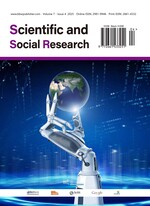Research on the Reconstruction and Communication Effect of Generative Artificial Intelligence on Communication Content: A Semiotic Perspective
Abstract
Generative artificial intelligence, as an important transformative force in contemporary communication technology, is profoundly changing the generation mechanism of communication content and the implementation path of communication effects. From a semiotic perspective, this article explores how AI technology can reconstruct the symbolic construction logic, content form, and discourse power structure in communication content, and further analyzes its impact on audience perception, information reception, and feedback mechanisms, communication controllability, and uncertainty at the level of communication effectiveness. Research has found that the deep intervention of AI has led to structured, programmatic, and mimetic dissemination of content. The decoding path of the audience is becoming increasingly complex, and the feedback is more immediate but lacks depth. At the same time, it also brings potential risks such as unclear ethical responsibilities and decreased information authenticity. At the end of the article, a thinking path for future communication research and practice is proposed from four dimensions: ethical regulation, platform responsibility, human-machine collaboration, and disciplinary integration, aiming to provide a theoretical reference for building a more rational, standardized, and human-oriented AI communication environment.
References
Zhao D, Wang M, Gu FF, et al., 2025, Acquiring Cross-border Business Customers: The Roles of Relevance and Novelty in Online Communication. Industrial Marketing Management, 2025(126): 1–17.
Dorleans EGF, Sicsic J, Henry V, et al., 2025, What are Parents’ Preferences for Human Papillomavirus Vaccination Promotion Messages and Communication? Application of a Discrete Choice Experiment to a French Caribbean Setting. BMC Public Health, 25(1): 145.
Shen A, Chow PK, 2024, Community Detection Framework Using Deep Learning in Social Media Analysis. Applied Sciences, 14(24): 11745.
Ly D, Overeem M, Brinkkemper S, et al., 2025, The Power of Words in Agile vs. Waterfall Development: Written Communication in Hybrid Software Teams. The Journal of Systems Software, 2025(219): 112243.
Ma S, Xie QH, Wang JX, et al., 2024, The Effect of Referral Tasks on Customers’ Referral Likelihood on Social Platforms. Nankai Business Review International, 15(4): 595–618.
Chiasson MR, Goodboy KA, Vendemia AM, et al., 2024, Does the Human Professor or Artificial Intelligence (AI) Offer Better Explanations to Students? Evidence from three within-subject Experiments. Communication Education, 73(4): 343–370.
Chu H, Liu H, Zhuo J, et al., 2025, Occlusion-guided Multi-modal Fusion for Vehicle-infrastructure Cooperative 3D Object Detection. Pattern Recognition, 2025(157): 110939.
Hu W, 2024, The Image of Cruise Tourism is Dislocated and Regulated from the Perspective of Tourism Gaze Based on the Differentiation and Harmony of OGC and TGC Images. Journal of Social Science Humanities and Literature, 7(3): 61–71.
Du Y, Huang X, Xie R, et al., 2024, Parents’ Experiences of Communicating with Children About Their Diagnosis of Nonterminal Cancer and Its Related Issues: A Systematic Review of Qualitative Studies. Cancer Nursing, Advanced Online Publication.
Stassen R, Zottarelli L, Rowan P, et al., 2024, Extreme Heat and Pregnancy: A Content Analysis of Heat Health Risk Communication by U.S. Public Health Agencies. Disaster Medicine and Public Health Preparedness, 18(71): 11–14.
Chen Q, 2025, A Study of Data Visualisation Methods for Reconstructing the Symbolic Transmission of Aboriginal Oral Traditions. Applied Mathematics and Nonlinear Sciences, 10(1): 1–20.
Iroegbu C, Tuot SD, Lewis L, et al., 2024, The Influence of Patient-Provider Communication on Self-Management Among Patients with Chronic Illness: A Systematic Mixed Studies Review. Journal of Advanced Nursing, 81(4): 1678–1699.
Sun Y, Yang M, 2025, Research on the Popularization of Marxism by Big Data Based on Attention Mechanism. Applied Mathematics and Nonlinear Sciences, 10(1): 1–17.
Yang Y, Liu Y, 2024, Constructing the Consciousness of the Chinese National Community through Media Communication in Ethnic Regions. Global Vision Research, 2024(1): 2.
Lei Y, Liang W, 2025, Exploration of the Digital Dissemination Mechanism of Red Culture in Youth Ideological and Political Education. Applied Mathematics and Nonlinear Sciences, 10(1): 1–15.

